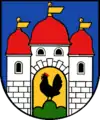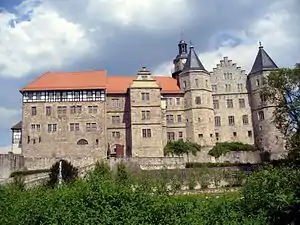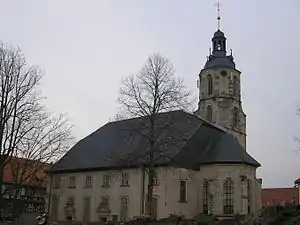Schleusingen
Schleusingen is a city in the district of Hildburghausen, in Thuringia, Germany. It is situated 10 km north of Hildburghausen, and 12 km southeast of Suhl.
Schleusingen | |
|---|---|
 Coat of arms | |
Location of Schleusingen within Hildburghausen district  | |
 Schleusingen  Schleusingen | |
| Coordinates: 50°31′0″N 10°45′0″E | |
| Country | Germany |
| State | Thuringia |
| District | Hildburghausen |
| Subdivisions | 7 |
| Area | |
| • Total | 125.56 km2 (48.48 sq mi) |
| Elevation | 372 m (1,220 ft) |
| Population (2019-12-31)[1] | |
| • Total | 10,930 |
| • Density | 87/km2 (230/sq mi) |
| Time zone | UTC+01:00 (CET) |
| • Summer (DST) | UTC+02:00 (CEST) |
| Postal codes | 98553 |
| Dialling codes | 036841 |
| Vehicle registration | HBN |
| Website | www.schleusingen.de |
Geography
The city of Schleusingen in the Henneberger Land got its name from the river Schleuse, which passes through its city districts Ratscher and Rappelsdorf. The city itself is located on the river Nahe, a tributary of the Schleuse, which runs south of the core city area. From the north, from Erlau, the Erle river joins the Nahe river in Schleusingen.
City Arrangement
The city of Schleusingen includes next to the core city another seventeen districts: Altendambach, Breitenbach, Erlau, Fischbach, Geisenhöhn, Gethles, Gottfriedsberg, Heckengereuth, Hirschbach, Hinternah, Oberrod, Rappelsdorf, Ratscher, Schleusingerneundorf, Silbach, Sankt Kilian and Waldau
In addition, terms for residential areas such as' 'Upper-' 'and' 'Lower Town, Schmuckplatz, Weißer Berg, Hirtengrund, Kalkrangen, Sonneneck, Rubetal ' etc. are common in the population.
History
Schleusingen was first mentioned in documents in 1232 as 'Villa Slusungen'. Earl Poppo VII of Henneberg built as a residence and fortification in the period from 1226 to 1232 the Bertholdsburg. 1274 was the division of the Shire Henneberg into three lines. The Bertholdsburg then became the residence of the Schleusinger line of the Earls of Henneberg. Schleusingen experienced a first fire catastrophe in the year 1353. Further town fires in 1679, 1765, 1773 and 1876 destroyed whole districts of the city.
In 1412 Schleusingen received the Stadtrecht (the right to be considered a city instead of a town) but only in 1533 the Marktrecht (the right to, among other things, hold a folk festival or a weekly market). In 1502 Earl Wilhelm IV. founded a Barfüsserkloster (monastery) in the outskirts. During the riots in the German Peasants' War in the spring of 1525, the inhabitants, documents and valuables of the neighboring monasteries Veßra and Trostadt were sent to Schleusingen to be brought to safety at the Bertholdsburg. In 1544 the Reformation was introduced. The Aegidienkapelle of the St. Johannis Church became the burial place of the Earls of Henneberg in 1566 and of Elisabeth of Brandenburg. The Barfüsserkloster was transferred into state ownership and from 1560 it was used as a school. On June 7, 1577 this school was inaugurated on as a Gymnasium (high school) and still exists today under the name Hennebergisches Gymnasium ‘Georg Ernst’]. Until 1583 Schleusingen was the seat of the Earls of Henneberg. After the death of Earl Georg Ernst), with whose death the royal line was extinguished, Schleusingen was transferred to the Saxon dukes of the Ernestine and the Albertiner line, at first under joined administration. From 1500 to 1806 Schleusingen belonged to the Franconian Imperial Circle.
Incorporations
- Fischbach on March 1, 1970
- Geisenhöhn and Gottfriedsberg on April 1, 1974
- Gethles, Ratscher and Heckengereuth on February 22, 1994
- Rappelsdorf on June 1, 1996
- Nahetal-Waldau and Sankt Kilian on July 6, 2018
Population Development
Population development '(from 1960 on 31 December respectively)' ':
|
|
|
Main sights
- Castle Bertholdsburg
- Townchurch St. Johannis
- Teutsche Schule
- market place



References
- "Bevölkerung der Gemeinden, erfüllenden Gemeinden und Verwaltungsgemeinschaften in Thüringen Gebietsstand: 31.12.2019". Thüringer Landesamt für Statistik (in German). August 2020.